

The State of Storytelling in the Internet Age. Podcasts are blowing up, great stories are reaching more people than ever, people are paying for content, and the modern web is giving the world a better platform to tell stories than the world has ever seen.
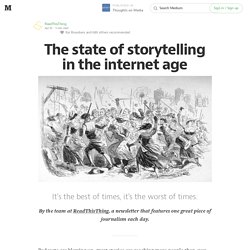
But news divisions are still shrinking, great publications are still failing, local blogs are still shutting down, and journalists are telling our youth to avoid the profession. The age of wisdom. » Newspaper reporter is ‘the worst job of 2015′ JIMROMENESKO.COM. – #200 out of 200 jobs/CareerCast graphic Newspaper reporter lands on the bottom of CareerCast’s Jobs Rated list for 2015.
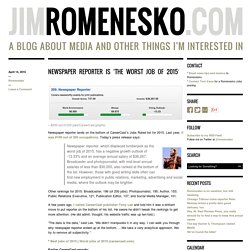
Last year, it was #199 out of 200 occupations. Today’s press release says: Good Old Fashioned Shoe Leather Reporting. The entire French legal code dating back to Napoleon is now on GitHub. Memo To Publishers: Watch Where You Put That Taproot… Memo To Publishers: Watch Where You Put That Taproot…

Q&A: Amy O’Leary on eight years of navigating digital culture change at The New York Times. When Amy O’Leary announced in early January that she was leaving The New York Times to become editorial director at Upworthy, there was a collective jaw-drop in the digital journalism community.

From silos to aggregators: On mobile, apps that cross news org boundaries continue to have a pull. Millennials say keeping up with the news is important to them — but good luck getting them to pay for it. Most millennials don’t seek out news on social media, but the vast majority of them get news from social networks once they see it there, according to a report released today by the Media Insight Project, a collaboration between the American Press Institute and the Associated Press-NORC Center for Public Affairs Research.
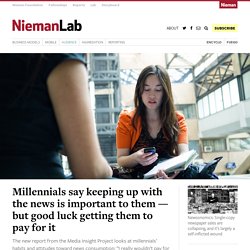
Only 47 percent of the millennials surveyed said consuming news is a major reason they visit Facebook, but 88 percent of the respondents said they get news from Facebook at least occasionally. 83 percent said they get news from YouTube on occasion, and 50 percent found news on Instagram. Next in line: Pinterest at 36 percent, Twitter at 33 percent, Reddit at 23 percent, and Tumblr at 21 percent. “Simply put, social media is no longer simply social,” the report says. My Year Ripping Off the Web With the Daily Mail Online. The Glamorous Life of a Journalist, Sponsored Content Edition — The Atlantic. "We are keen to establish a mutually beneficial relationship with you.

" Who could resist a possibility like this? Over the past few weeks I've received emails like the one below almost every day. Hi there, I am just contacting you to see if you would be interested in hosting some third party content on your website, theatlantic.com? I am currently working with a sports betting website to find websites to submit unique articles to which link back to our client's website. We would make the article look natural by choosing a topic which is relevant to your website. How Vocativ Mines The "Deep Web" For Storytelling.
Back in 2012, a group of digital journalists went hunting for Ugandan warlord Joseph Kony. They tried to track him using a trove of data--like mercenary chatter found on an obscure corner of the web. In the end, they weren't exactly able to string together enough information to triangulate his position. But Kony wasn't the only signal they were tracking. By setting geographic parameters for a data-analysis operation and opening their ears, the analysts and journalists of a new kind of news organization called Vocativ stumbled upon talk on a message board about something equally as curious as the Lord's Resistance Army's leader's movements.
They found a thriving Facebook subculture of gun sweepstakes where gun shops and industry publications would give away weapons, including AR-15 rifles, to random fans who “liked” their page. The Facebook guns story wasn't what reporters and analysts went looking for. A wave of distributed content is coming — will publishers sink or swim? Editor’s note: The new issue of our sister publication Nieman Reports is out and ready for you to read.
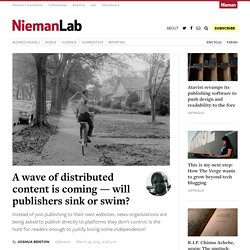
I write a column for the print edition of the magazine; here’s mine from the new issue. It deals with distributed content — a very hot topic given the Facebook news of the last 24 hours (though I wrote this before that news broke). Last August, when BuzzFeed announced a new $50 million round of venture capital investment, a lot of journalists heard a new phrase for the first time: distributed content.
Newspaper Industry Is Running Out of Time to Adapt to Digital Future. While the rest of us were burning hot dogs on the grill last week, the newspaper industry seemed to be lighting itself on fire.

There have been cracks in publishing operations that are both hilarious and terrifying. The Times-Tribune in Scranton, Pa., published a box score for a baseball game that was never played, after one of the coaches made up a result to spare the other team the embarrassment of a forfeit. The U-T, the daily newspaper of San Diego, published a two-week-old blog post — on its front page. Local News in a Digital Age. Whether in a tech-savvy metropolis or a city where the town square is still the communication hub, local news matters deeply to the lives of residents.
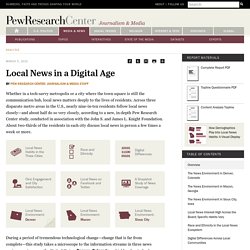
Across three disparate metro areas in the U.S., nearly nine-in-ten residents follow local news closely—and about half do so very closely, according to a new, in-depth Pew Research Center study, conducted in association with the John S. and James L. Knight Foundation. About two-thirds of the residents in each city discuss local news in person a few times a week or more. Studying the ways that local news flows in a city’s population requires more than one tool in the social scientist’s tool kit. Jonah Lehrer Wasn’t the Only Journalist Shaping His Conclusions. We are all bad apples,” wrote Jonah Lehrer, in probably the last back-cover endorsement of his career.
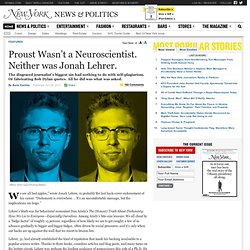
“Dishonesty is everywhere … It’s an uncomfortable message, but the implications are huge.” Lehrer’s blurb was for behavioral economist Dan Ariely’s The (Honest) Truth About Dishonesty: How We Lie to Everyone—Especially Ourselves. Among Ariely’s bite-size lessons: We all cheat by a “fudge factor” of roughly 15 percent, regardless of how likely we are to get caught; a few of us advance gradually to bigger and bigger fudges, often driven by social pressures; and it’s only when our backs are up against the wall that we resort to brazen lies. Lehrer, 31, had already established the kind of reputation that made his backing invaluable to a popular science writer. The New York Times Is Screwing With Us, Right? After reading this piece today, which declares, “In New York, teens and preteens are becoming savvy connoisseurs of real estate,” I am officially convinced the New York Times is trolling us. A 13-year-old convincing his parents to buy a $14 million dream apartment?
Journalism in the Age of the Accidental News Junkie — The Atlantic. A study of Millennial media habits claims that young people crave hard news. Do they really? Young Americans care about the news, honestly they do, but their discovery path typically winds through social media feeds, not through newspapers, news sites, or televised news coverage. That is one of the major conclusions of a new report on Millennial media habits, which finds that 80 percent of young people get their news from online sources, and social networks are replacing network news as the daily touchstone for current affairs. Nearly 90 percent of young people get news from Facebook regularly, but less than half say that news is their main motivation for visiting Facebook's site or app. (Nor is news the primary purpose for Millennials on Twitter, even though Twitter is a popular destination for journalists and news junkies.)
The American Press Institute's report claims that young people care about the news quite a bit. No, not quite "politics, crime, [and] their local community. " Amway Journalism. Zite. The Human Algorithm. When I became a reporter, almost 20 years ago, my job was to dig up scarce, precious facts and deliver them to a passive audience.
Today, scarcity has been replaced by an unimaginable surplus and that audience is actively building its own newsroom. Why Social Media Reinvigorates the Market for Quality Journalism. What Is a Curator in Chief? Neil Sanderson is the Chief Curator at Eqentia--a software platform service that enables professional users and organizations to easily aggregate, curate and republish the news that's important to them. Eqentia's sites are both public and private--with some of the more public ones including Visability Marketing (visabilitymarketing.com) and Slices of Boulder (slicesofboulder.com) which is a local news website for Boulder, Colorado.
Viral Journalism and the Valley of Ambiguity. How much does search engine optimization play into how effectively a story is picked up virally? Jeff Jarvis on what I’ve been beginning to call “The Content Creator’s Dilemma” Recollection: A Collaborative Tool For Sharing And Visualizing Cultural Data. As digital tools move on, standards change, and interoperability fails, we lose access to older information. As our history becomes harder to access, only the newest information rises to the top, leaving us with a collective digital memory that is foggy on anything but the most recent past. To correct this problem, the Library of Congress is debuting Recollection, a free platform developed by the LoC's digital preservation program, with help from information architecture company Zepheira, to preserve and present digital history. The idea behind Recollection is simple: it allows the LoC and its cultural heritage partner institutions to easily pool and visualize their collections.
What was a giant, unwieldy database can be easily transformed into an interactive timeline, map, tag cloud, or a range of other highly readable interfaces. Future of Journalism. The Human Algorithm. When I became a reporter, almost 20 years ago, my job was to dig up scarce, precious facts and deliver them to a passive audience.